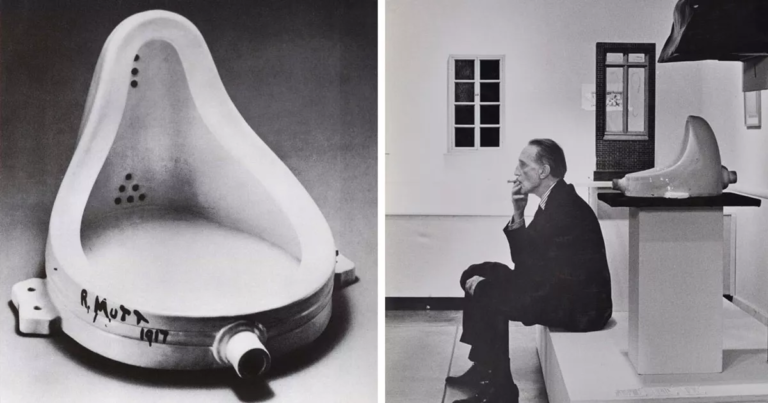Marcel Duchamp is regarded as one of the most influential artists of the 20th century. One of his works that created a radical shift in the art world is his 1917 piece titled “Fountain.” This artwork is known as one of the most significant and controversial pieces of modern art and serves as a tangible example of Duchamp’s artistic philosophy.
Fountain: A Challenge to Traditional Art

“Fountain” is a simple urinal signed “R. Mutt.” With this piece, Duchamp sparked a profound debate about what art is, what it could be, and the role of the artist. This “ready-made” artwork introduced the idea that everyday objects could be presented as art. Fountain, more than just a urinal, became a symbol of questioning the definition and value of art.
The Concept of Ready-Made and Fountain

Duchamp’s “Fountain” is the most well-known example of the “ready-made” concept. The term “ready-made” refers to an object selected by an artist to be presented as an artwork without any artistic modification. With this approach, which challenged the traditional aesthetic norms of the art world, Duchamp offered a new perspective on what art could be. In this sense, “Fountain” argues that the creative process in art lies more in the artist’s choice and presentation than in the object itself.
The Impact on the Art World

“Fountain” caused a major stir in the art world. The piece was submitted to an exhibition in New York in 1917 but was rejected by the exhibition committee. This incident caused a widespread reaction in the art community and sparked an important discussion about the boundaries of art. Duchamp’s bold move had a significant impact on the art world, contributing to the start of a new era beyond traditional understandings of art.
Fountain and Dadaism

“Fountain” is also considered an important representative of the Dadaism movement. Dadaism was an art movement that emerged during World War I and challenged traditional art conventions. With “Fountain,” Duchamp embodied the Dadaists’ idea that art was not only an aesthetic value but also a tool for expressing ideas and protest. This work demonstrated that art could be created with ordinary objects and that these objects could serve as a form of artistic expression.
The Legacy of Fountain and Its Influence on Modern Art

Marcel Duchamp’s “Fountain” has left a lasting mark on modern art history. The piece continues to be a symbol of discussion in the art world today. Duchamp’s radical approach changed the universal definition of art and inspired future art movements. “Fountain” is considered one of the cornerstones of modern art and continues to play a significant role in the creative processes of contemporary artists.
Redefining the Boundaries of Art
“Fountain” reflects Marcel Duchamp’s effort to redefine art and the artist. This work showed that art is not only an aesthetic value but also an idea and a concept. With “Fountain,” Duchamp expanded the boundaries of art, offering viewers a new perspective on what art could be. In the evolution of art and the shaping of modern art, “Fountain” holds a unique place and continues to stand as a symbol of Duchamp’s visionary approach to art history.
Marcel Duchamp’s “Fountain” is recognized as one of the cornerstones of modern art. The keywords “Fountain” and Duchamp’s name resonate with audiences interested in art. The “Fountain” piece, associated with Dadaism and the ready-made concept, stands out as a work that redefined art and shaped art history.


